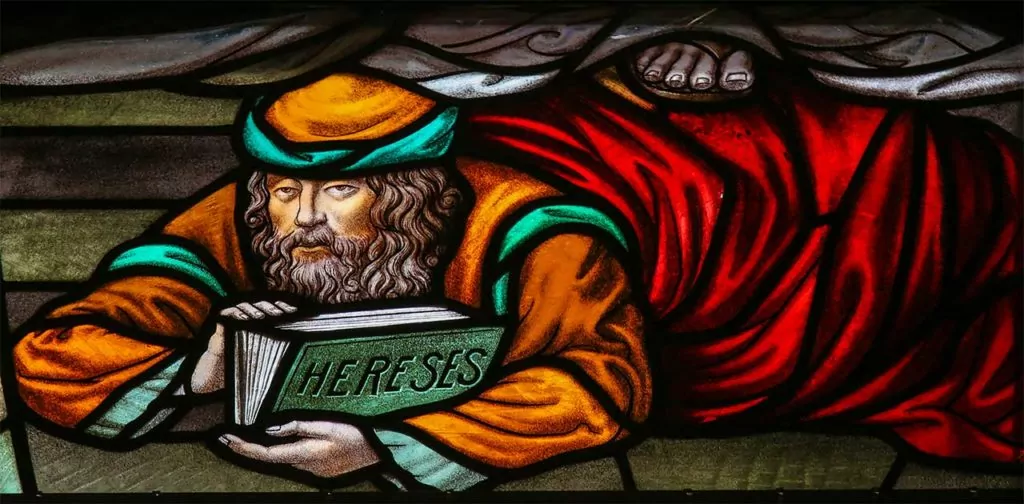The word “orthodoxy” comes from the Greek orthos which means right, true, or straight, and doxa which is praise, or opinion. Therefore, orthodoxy is having the right opinion on a specific topic, usually religious.
In the early church, orthodoxy had to be discovered and established by means of study, debate, and decisions. While the early church was quite unanimous in the use of baptism in the Name of the Father, Son, and Holy Spirit, there was some significant disagreement about the nature of the interrelationship between, and nature of, each person of the Trinity. For example, Sabellianism taught that there was not three distinct persons in the Trinity, but that God simply manifested himself differently for different purposes: God was Father at Creation, Son at Redemption, and Spirit in Sanctification.
Attending to Arius
The impetus for articulating the Nicene Creed, however, was not in response to Sabellianism, although it certainly addresses this belief, but in response to Arianism. Arius taught that Jesus was the first created being, created from nothing, and inferior to God. As Bruce Shelley puts it in his, Church History in Plain Language:
“He was a lesser being or half-God, not the eternal and changeless Creator. He was a created Being – the first created Being and the greatest, but nevertheless himself created.”
Arius was an elder in Alexandria, and the bishop of that city was Alexander, whom Arius falsely accused of Sabellianism. However, Arius and his followers were eventually deposed and excommunicated by a Council held in Alexandria, and including 100 bishops from Egypt and Libya.
But his deposition did not keep Arius from hosting religious assemblies and sharing his views. Even some well-positioned bishops empathized or agreed with his position. As time progressed, “Alexander vs. Arius” became a dividing point between bishops, between provinces, and started to cause increased division in the church.
The emperor at this time was Constantine. He noticed that the debate on the nature of Christ was dividing the Church and might even be a threat to the empire. In a startling shift from the severe persecution by Diocletian the previous emperor, Constantine invited bishops and elders from all across the empire, at his expense, to come to Nicea, in order to reach a consensus on this important issue. There were between 1500-2000 attendants at this council.
In his History of the Christian Church, Philip Schaff explains that the members of the council were divided into three camps. The smallest camp was made up of members who believed in the deity of Christ from eternity (i.e., Alexander, Athanasius, etc.). The second group was made up of those who agreed that Christ was created and of a lesser substance then the Father (i.e., Arius, etc.). The third group, the vast majority, leaned towards the orthodox position, but were undiscerning and did not seem to care for doctrinal debates or scholastic discussions. They could have been prepared to accept a compromised position.
Arius’ camp proposed the first summary of their position; their creed was quickly dismissed and the debate must have been convincing. Sixteen of the eighteen original proponents of the Arian creed abandoned the cause.
No room for compromise
Eusebius, a church historian at that time, presented an alternative creed, originally approved by Emperor Constantine. It was similar to the completed Nicene Creed, but missing the claim that Christ was of the same substance as the Father. It acknowledged, in general terms, the divine nature of Christ, but was not explicit in articulating the co-equality and co-eternality of Christ with the Father. The Arian camp was prepared to adopt the creed as presented by Eusebius which caused the camp of Alexander and Athanasius to be quite suspicious. They wanted a creed that Arians would reject entirely. There was no room for compromise. They continued to insist on the inclusion of the phrase “of one substance” which Arians rejected as Sabellianism – that the Trinity is three modes of the one God, not three persons. However, as the debate continued, Constantine noticed that Eusebius’ creed would not pass, and so he gave his consent to insert and include “of one substance” in the creed.
The version of the Nicene Creed, adopted by the Council and signed by most of the members at the Council read thus:
“We believe in on God, the Father Almighty, Maker of all things visible and invisible.
“And in one Lord Jesus Christ, the Son of God, begotten of the Father, the only begotten; that is of the essence of the Father, God of God, Light of Light, very God of very God, begotten, not made, being of one substance with the Father; by whom all things were made both in heaven and on earth; who for us men, and for our salvation, came down and was incarnate and was made man; he suffered, and the third day he rose again, ascended into heaven; from then he shall come to judge the quick [living] and the dead.
“And in the Holy Ghost.
“But those who say: ‘There was a time when he was not;’ and ‘He was not before he was made;’ and ‘He was made out of nothing’ or ‘He is of another substance’ or ‘essence,’ or ‘The Son of God is created,’ or ‘changeable,’ or ‘alterable’ – they are condemned by the holy catholic and apostolic Church.” (Philip Schaff’s Creeds of Christendom, Vol. 1)
This is the first instance in the Christian Church that office-bearers signed such a document. It expresses agreement with, and also submission to, the content of this creed. Eusebius, the one who had presented the creed without “of one substance” was prepared to sign this creed without the last paragraph, the condemnation of Arius teaching, and for this he was deposed and banished until he later conceded to sign the creed in its entirety. In the end, only two bishops, together with Arius, refused to sign and were banished. This is also the first time that there was a civil consequence applied because of church issues. The separation of church and state was eroding quickly.
Round 2
We might think the story ends here and the debate on the nature of Christ and his relationship to the Father is finished. We’d be sorely mistaken. Some of those who had signed this did so because of the Emperor’s approval of it. As such, it didn’t take long for some of them came to the defence of Arius.
Eusebius the historian (who presented the compromised creed) starting to throw all of his influence against those who supported the phrase “of one substance.” Even Constantine was convinced at some point of the idea that Christ was created “of a like substance” to the Father (not the same), but eventually came back from that. However, Arius was no longer banished and he was expecting to take up his place as elder as he had previously, but by this time Athanasius was the bishop and refused to reappoint him to the office. However, two Arian councils were held that condemned Athanasius, and even the Emperor banished the bishop for being a disturber of the peace.
Arius was formally acquitted by a council in Jerusalem (A.D. 335) and was to be received as a full member by the church at Constantinople. Schaff goes on to explain,
“But on the evening before the intended procession from the imperial palace to the church of the Apostles, he suddenly died (A.D. 336), at the age of over eighty years, of an attack like cholera, while attending to a call of nature. This death was regarded by many as a divine judgment; by others, it was attributed to poisoning by enemies; by others, to the excessive joy of Arius in his triumph.”
Athanasius had to wait until the death of Constantine (337) to be recalled from his banishment (338) by Constantine II.
A few months later, he convened a Council in Alexandria to reaffirm the Nicene Creed, but his victory was short lived. The changing emperors, the constant divide between the Eastern and Western portions of the empire with regards to church doctrine, and the opposing Councils hosted by various bishops did nothing to bring peace or unity. At one point, Constantius, a son of Constantine, held three successive synods that supported a moderate Arianism (i.e., “of like substance”) and forced the decrees of these councils on the entire Church, East and West, and then deposed and banished bishops. At then, as Schaff highlights, he even brought in the troops:
“[Constantius] drove Athanasius from the cathedral of Alexandria during divine service with five thousand armed soldiers and supplied his place with an uneducated and avaricious Arian.”
For a number of decades, through various emperors, the fight for orthodoxy seemed grim. At some point, even in the city of Constantinople, there was only one congregation, pastored by Gregory Nanzianen, that remained faithful to the Nicene Creed. Many bishops had been banished, recalled, banished again, etc., depending on the emperor’s perspective. During a short period of a revival of paganism, under the rule of Julian that Apostate, both parties were invited to exist side by side as he wanted the Church to keep fighting among itself in order to destroy itself.
Finally, in 381, Theodosius the Great, who was educated in the Nicene faith, called the second ecumenical council at Constantinople in May. Only bishops from the East came to this Council, it seems, as the Roman (Latin) church was quite agreed with the orthodox position. This Council did not create a new creed, but they rearticulated the Nicene Creed, as we have it today, for the most part. Schaff explains that, by July, the emperor “enacted a law that all churches should be given up to bishops who believed in the equal divinity of the Father, the Son, and the Holy Ghost… the public worship of heretics was forbidden.”
Conclusion
Orthodoxy had to be discovered and defended. Today, almost anyone who identifies as a Christian confesses the truth of the Trinity as expressed in the Nicene Creed (Mormons and Jehovah’s Witnesses are significant exemptions). I sometimes wonder if we truly appreciate the battles that were fought in order to maintain truth and to keep a right understanding of scripture. This, of course, is the most significant outcome of the battle for and around the Nicene Creed.
However, two other major points that were mentioned briefly should be reconsidered for a moment.
First, the importance of adding one’s signature to the Creed at the first Council: office-bearers today also sign a form of subscription when they enter upon their respective offices. We do this, in part, to protect orthodoxy, and the orthodoxy of our churches, as it were. We express agreement with the Ecumenical and Reformed Creeds, and should we have any concerns with any part of them, we agree not to address them in public, and to submit to the decisions of our local consistory or classis. Doing otherwise would lead to being suspended from the office. This sounds similar to what happened at the Council of Nicea.
The second important point is the role of the government in these affairs. Once Constantine championed Christianity, the emperors that followed thereafter had a significant role on the formation, deformation, and reformation of the Church. Under Constantine’s rule, the Church enjoyed an unprecedented sense of prestige, protection, and power but with the change of an emperor, things quickly changed.
However, the truth of God’s Word does not change with changing circumstances. That’s important to keep in mind, as today again, the Church’s circumstances have changed dramatically from even fifty years ago. In the West the Church is no longer held in any sort of regard, but is considered a fringe organization, especially when it persists in defending orthodoxy. Many churches have reacted to the changing of society by changing what they consider to be orthodox.
May faithful churches today continue to strive in remaining faithful to the entirety of God’s Word, to his honor, and all the more so when persecution, tribulations, and trials come our way. Culture does not define or set the parameters of the truth of God’s Word, but God’s truth should define what is acceptable and good to cultivate.
Dr. Chris deBoer is the Executive Director of Reformed Perspective Foundation.












